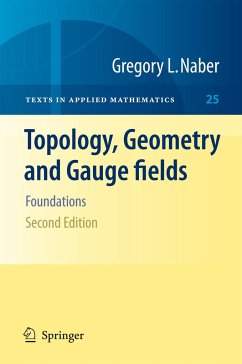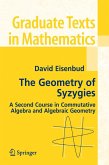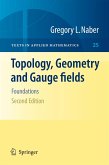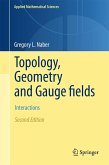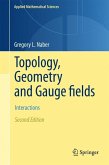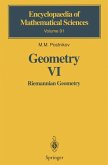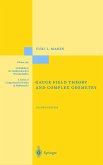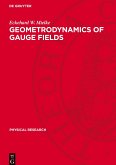This is a book on topology and geometry and, like any books on subjects as vast as these, it has a point-of-view that guided the selection of topics. Naber takes the view that the rekindled interest that mathematics and physics have shown in each other of late should be fostered and that this is best accomplished by allowing them to cohabit. The book weaves together rudimentary notions from the classical gauge theory of physics with the topological and geometrical concepts that became the mathematical models of these notions. We ask the reader to come to us with some vague notion of what an electromagnetic field might be, a willingness to accept a few of the more elementary pronouncements of quantum mechanics, a solid background in real analysis and linear algebra and some of the vocabulary of modern algebra. To such a reader we offer an excursion that begins with the definition of a topological space and finds its way eventually to the moduli space of anti-self-dual SU(2) connections on S4 with instanton number -1. Iwould go over both volumes thoroughly and make some minor changes in terminology and notation and correct any errors I find.In this new edition, a chapter on Singular Homology will be added as well as minor changes in notation and terminology throughout and some sections have been rewritten or omitted. Reviews of First Edition:"It is unusual to find a book so carefully tailored to the needs of this interdisciplinary area of mathematical physics...Naber combines a knowledge of his subject with an excellent informal writing style."(NZMS Newletter)"...this book should be very interesting for mathematicians and physicists (as well as other scientists) who are concerned with gauge theories."(Zentralblatt Fuer Mathematik)
First Edition Review:
"Naber's book, together with its predecessor[N4] subtitled Foundations, occupies a less populated niche in the market. This is the sector of teachable texts on differential geometry and its use in physics. Teachability does not refer to a definition-theorem-proof format. Nor does it imply anything about the depth of the treatment. Rather, it has to do with the organization of the topics, the selection of examples, the amount of instructive details provided, the ability to anticipate questions from the reader, and knowing when to stop."
--SIAM REVIEW
"Naber's book, together with its predecessor[N4] subtitled Foundations, occupies a less populated niche in the market. This is the sector of teachable texts on differential geometry and its use in physics. Teachability does not refer to a definition-theorem-proof format. Nor does it imply anything about the depth of the treatment. Rather, it has to do with the organization of the topics, the selection of examples, the amount of instructive details provided, the ability to anticipate questions from the reader, and knowing when to stop."
--SIAM REVIEW
From the reviews:
MATHEMATICAL REVIEWS
"The presentation in the remaining five chapters is enriched by detailed discussions about the physical interpretations of connections, their curves and characteristic classes. I particularly enjoyed Chapter 2 where many fundamental physical examples are discussed at great length in a reader friendly fashion. No detail is left to the reader's imagination or interpretation. I am not aware of another source where these very important examples and ideas are presented at a level accessible to beginners...The topics covered in this book can be found in many other sources, but the present volume discusses with great care those aspects and notions which are particularly important in gauge theory. Moreover, the presentation is backed by many useful and relevant examples and I am convinced that any beginner in gauge theory will find them very useful."
NZMS NEWSLETTER
"It is unusual to find a book so carefully tailored to the needsof this interdisciplinary area of mathematical physics...Naber combines a knowledge of his subject with an excellent informal writing style."
SIAM REVIEW
"Naber writes in a most unpretentious style. His prose is not terse like Rudin's, but not verbose either. He gives full details to all difficult calculations and shows good judgment in deciding what is difficult versus what is not. This is one way in which a writer demonstrates rapport with his/her readers. Never once has Naber omitted anything out of laziness, under the pretense that it is routine. The book is carefully thought out and lecture-tested account of the subject matter listed earlier. It is rigorous, with an emphasis on the details in the examples. Naber favors examples that deal with concrete spaces and revisits them whenever appropriate...In terms of its ability to teach a subject to the novice, this book ranks right up there with many classics...People who collect classics should consider buying this one, whether or not they plan to study it chapter by chapter. For someone who plans to compute right along with the examples, this book is a must-buy. Naber's goal is not to teach a sterile course on geometry and topology, but rather to enable us to see the subject in action, through gauge theory. The book is capable of fulfilling this goal because of Naber's efforts. He has undertaken the arduous task of researching the broad field with its extensive literature, learning the material himself, class testing it in lectures, and agonizing over the best ways to present it. Amazingly, the fruits of his labor can be had for less than $70, thanks to Springer's consumer-friendly pricing...[the reviewer] hopes that Naber will continue the scholarly program of bringing exciting mathematics and physics to a level of clarity that is within our reach."
REVIEWS OF TOPOLOGY, GEOMETRY, AND GAUGE FIELDS: FOUNDATIONS
"It is unusual to find a book so carefully tailored to the needs of this interdisciplinary area of mathematical physics...Naber combines a knowledge of his subject with an excellent informal writing style."
NZMS NEWSLETTER
"...this book should be very interesting for mathematicians and physicists (as well as other scientists) who ae concerned with gauge theories."
ZENTRALBLATT FUER MATHEMATIK
From the reviews of the second edition:
"The focus of the book under review is the interaction between topology, geometry and gauge fields. ... The book thus serves as both a solid and an enticing introduction to the mathematics required for the geometric formulation of gauge theory. Self-study and employment as a textbook are aided by 228 exercises peppered throughout the text." (Peter R. Law, Mathematical Reviews, August, 2013)
"The author carries on the study on the program initiated in his book Topology, geometry and gauge fields. Foundations ... . There are 228 exercises that essentially constitute fragments of proofs of theorems. The bibliography consists of 67 titles. A symbol and a subject index are included. This book is warmly recommended to specialists in mathematics and physics, and especially to PhD students interested in the topic." (Jan Kurek, Zentralblatt MATH, Vol. 1233, 2012)
MATHEMATICAL REVIEWS
"The presentation in the remaining five chapters is enriched by detailed discussions about the physical interpretations of connections, their curves and characteristic classes. I particularly enjoyed Chapter 2 where many fundamental physical examples are discussed at great length in a reader friendly fashion. No detail is left to the reader's imagination or interpretation. I am not aware of another source where these very important examples and ideas are presented at a level accessible to beginners...The topics covered in this book can be found in many other sources, but the present volume discusses with great care those aspects and notions which are particularly important in gauge theory. Moreover, the presentation is backed by many useful and relevant examples and I am convinced that any beginner in gauge theory will find them very useful."
NZMS NEWSLETTER
"It is unusual to find a book so carefully tailored to the needsof this interdisciplinary area of mathematical physics...Naber combines a knowledge of his subject with an excellent informal writing style."
SIAM REVIEW
"Naber writes in a most unpretentious style. His prose is not terse like Rudin's, but not verbose either. He gives full details to all difficult calculations and shows good judgment in deciding what is difficult versus what is not. This is one way in which a writer demonstrates rapport with his/her readers. Never once has Naber omitted anything out of laziness, under the pretense that it is routine. The book is carefully thought out and lecture-tested account of the subject matter listed earlier. It is rigorous, with an emphasis on the details in the examples. Naber favors examples that deal with concrete spaces and revisits them whenever appropriate...In terms of its ability to teach a subject to the novice, this book ranks right up there with many classics...People who collect classics should consider buying this one, whether or not they plan to study it chapter by chapter. For someone who plans to compute right along with the examples, this book is a must-buy. Naber's goal is not to teach a sterile course on geometry and topology, but rather to enable us to see the subject in action, through gauge theory. The book is capable of fulfilling this goal because of Naber's efforts. He has undertaken the arduous task of researching the broad field with its extensive literature, learning the material himself, class testing it in lectures, and agonizing over the best ways to present it. Amazingly, the fruits of his labor can be had for less than $70, thanks to Springer's consumer-friendly pricing...[the reviewer] hopes that Naber will continue the scholarly program of bringing exciting mathematics and physics to a level of clarity that is within our reach."
REVIEWS OF TOPOLOGY, GEOMETRY, AND GAUGE FIELDS: FOUNDATIONS
"It is unusual to find a book so carefully tailored to the needs of this interdisciplinary area of mathematical physics...Naber combines a knowledge of his subject with an excellent informal writing style."
NZMS NEWSLETTER
"...this book should be very interesting for mathematicians and physicists (as well as other scientists) who ae concerned with gauge theories."
ZENTRALBLATT FUER MATHEMATIK
From the reviews of the second edition:
"The focus of the book under review is the interaction between topology, geometry and gauge fields. ... The book thus serves as both a solid and an enticing introduction to the mathematics required for the geometric formulation of gauge theory. Self-study and employment as a textbook are aided by 228 exercises peppered throughout the text." (Peter R. Law, Mathematical Reviews, August, 2013)
"The author carries on the study on the program initiated in his book Topology, geometry and gauge fields. Foundations ... . There are 228 exercises that essentially constitute fragments of proofs of theorems. The bibliography consists of 67 titles. A symbol and a subject index are included. This book is warmly recommended to specialists in mathematics and physics, and especially to PhD students interested in the topic." (Jan Kurek, Zentralblatt MATH, Vol. 1233, 2012)

